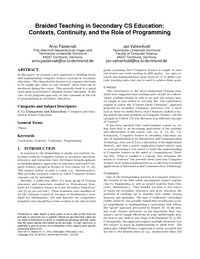Braided Teaching in Secondary CS EducationContexts, Continuity, and the Role of Programming
Erstpublikation in: SIGCSE’10, March 10–13, 2010, Milwaukee, Wisconsin, USA.
Publikationsdatum:
Zu finden in: SIGCSE 2010 (Seite 204 bis 208), 2009
|
 |
 Diese Seite wurde seit 2 Jahren inhaltlich nicht mehr aktualisiert.
Unter Umständen ist sie nicht mehr aktuell.
Diese Seite wurde seit 2 Jahren inhaltlich nicht mehr aktualisiert.
Unter Umständen ist sie nicht mehr aktuell.
 Zusammenfassungen
Zusammenfassungen
 In this paper, we propose a new approach to thinking about
and implementing Computer Science curricula in secondary
education. The characteristic feature is to organize the items
to be taught into what we call "strands" which then can be
interlaced during the course. This naturally leads to a spiral
curriculum in secondary Computer Science education. In the
view of our proposed approach, we also comment on the role
of programming in secondary education.
In this paper, we propose a new approach to thinking about
and implementing Computer Science curricula in secondary
education. The characteristic feature is to organize the items
to be taught into what we call "strands" which then can be
interlaced during the course. This naturally leads to a spiral
curriculum in secondary Computer Science education. In the
view of our proposed approach, we also comment on the role
of programming in secondary education. Dieser Text erwähnt ...
Dieser Text erwähnt ...
 Dieser Text erwähnt vermutlich nicht ...
Dieser Text erwähnt vermutlich nicht ... 
 Nicht erwähnte Begriffe | Informatik-Didaktik, Lehrplan 21 |
 Tagcloud
Tagcloud
 Zitationsgraph
Zitationsgraph
 Zitationsgraph (Beta-Test mit vis.js)
Zitationsgraph (Beta-Test mit vis.js)
 3 Erwähnungen
3 Erwähnungen 
- 25 Jahre Schulinformatik - Zukunft mit Herkunft (Gerhard Brandhofer, Gerald Futschek, Peter Micheuz, Anton Reiter, Karl Schoder) (2010)


- Fach- und bildungswissenschaftliche Grundlagen für den Informatikunterricht in der Sekundarstufe I (Arno Pasternak) (2013)


- Informatik erweitert Horizonte - 15. GI-Fachtagung "Informatik und Schule" - INFOS 2013 - 26.- 28.09.2013 (2013)


- «Ich glaube, Google ist so was wie eine Vorhalle des Internets» - Erste Ergebnisse einer qualitativen Untersuchung von Schülervorstellungen von der Suchmaschine Google (Oliver Seifert, Tony Sauck, Maximilian Schwarzbach, Christopher Lerch, Martin Weinert, Maria Knobelsdorf)

- «Ich glaube, Google ist so was wie eine Vorhalle des Internets» - Erste Ergebnisse einer qualitativen Untersuchung von Schülervorstellungen von der Suchmaschine Google (Oliver Seifert, Tony Sauck, Maximilian Schwarzbach, Christopher Lerch, Martin Weinert, Maria Knobelsdorf)
 Anderswo finden
Anderswo finden
 Volltext dieses Dokuments
Volltext dieses Dokuments
 |  Braided Teaching in Secondary CS Education: Artikel als Volltext ( Braided Teaching in Secondary CS Education: Artikel als Volltext ( : :  , 172 kByte; , 172 kByte;  : :  2021-03-21) 2021-03-21) |
 Anderswo suchen
Anderswo suchen 
 Beat und dieser Text
Beat und dieser Text
Beat hat Dieser Text während seiner Zeit am Institut für Medien und Schule (IMS) ins Biblionetz aufgenommen. Beat besitzt kein physisches, aber ein digitales Exemplar. Eine digitale Version ist auf dem Internet verfügbar (s.o.). Es gibt bisher nur wenige Objekte im Biblionetz, die dieses Werk zitieren.









 computer science unplugged
computer science unplugged LOGO (Programmiersprache)
LOGO (Programmiersprache) Programmieren
Programmieren Scratch
Scratch





 Biblionetz-History
Biblionetz-History